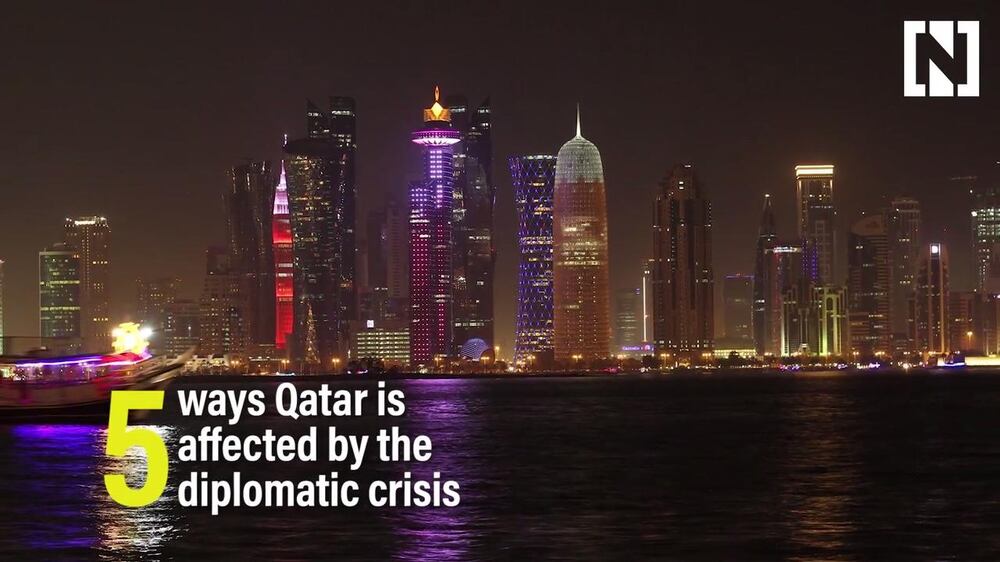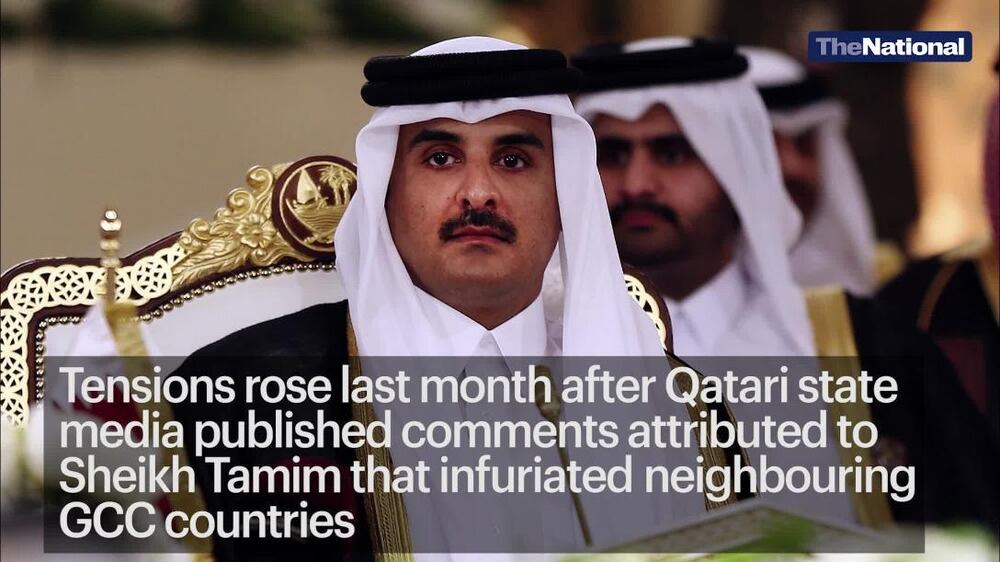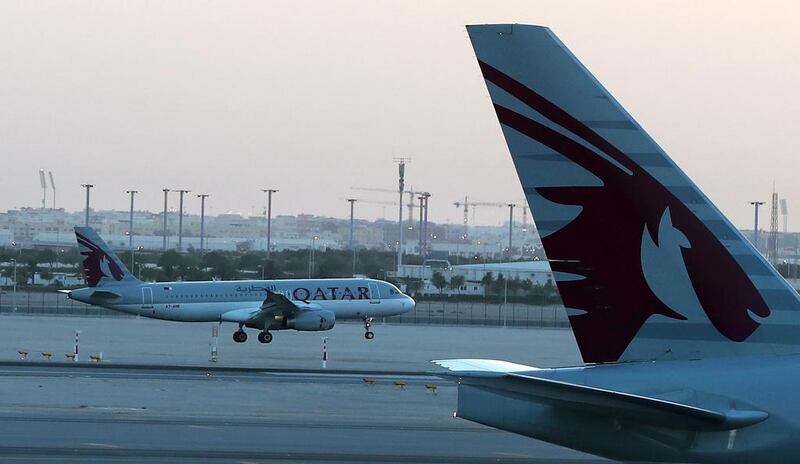The third month into the diplomatic crisis, the most serious since the founding of the Gulf Cooperation Council in 1981, Qatar’s intransigence towards the quartet of Saudi Arabia, the UAE, Bahrain and Egypt continues.
Doha’s defiant stance towards its Arab neighbours has come at a high price. The country, which supplies about a third of the world’s total liquefied natural gas (LNG), has been forced to tap into its foreign currency reserves and borrow from debt markets to support its economy, which is facing the prospect of posting a fiscal deficit. Yesterday the country’s sovereign wealth fund was compelled to reduce its stake in Credit Suisse to 4.94 per cent
Trouble for Qatar began when the Arab bloc led by Saudi Arabia severed diplomatic and transport relations with Doha over accusations of meddling in their internal affairs as well the country’s support for “terrorist groups aiming to destabilise the region”.
5 ways Qatar is affected by diplomatic crisis

The last diplomatic crisis in 2014 took almost eight months to resolve, when Saudi Arabia, Bahrain and the UAE chose to withdraw their diplomatic staff from Doha over similar allegation. A de-escalation this time could take even longer, as Doha, so far, has not responded to mediation efforts led by Kuwait and rounds of the shuttle diplomacy by US.
The longer the row continues, the worse it will be for Qatar's economy. That is the case especially when it comes to the growth of the non-oil sector, which could slow to 3.6 per cent this year from about 5.6 per cent last year, according to Abu Dhabi Commercial Bank and Economist Intelligence Unit (EIU) estimates.
Investors’ confidence is wearing thin – evident by sluggish trading on the Qatar Exchange -- and the prospects of foreign direct investments are waning. Banks are facing the possibility of funds’ outflow and the cost of borrowing for lenders is on the rise as rating agencies changed their outlook on major financial institutions in the country. The cost of imports, especially food items, has climbed, stoking fears of fast rising inflation.
The construction sector is also finding it difficult to procure supplies to continue building projects, which also casts doubt on Doha’s ability to finish on time all the stadiums and infrastructure projects it needs to successfully host the World Cup football tournament in 2022. The transportation and tourism sectors have also taken a hit, with the country’s flag-carrier, Qatar Airways, having to fly longer routes, adding to its operational costs.
Export of LNG, which accounts for about 60 per cent of Doha’s revenues, is also facing headwinds as customers use the row with Arab neighbours as leverage to lower prices.
It is a nightmare scenario. It’s clearly in Doha’s interest to take steps to end the impasse that is stifling growth. Its intransigence comes at a high opportunity cost.
State of the economy
Although it has the highest per capita income in the world, Qatar’s overall economic growth is expected to weaken and the country is likely to post a fiscal deficit this year. As an Opec member, Qatar has to comply with oil output cuts, which adds further pressure on its ability to generate revenues, economists said.
The EIU is forecasting the economy growing 1.6 per cent for 2017-18, while Oxford Economics is projecting gross domestic product (GDP) expanding by 1.4 per cent.
“We expect the economic growth to be weak for 2017-18, owing to the likely impact of the current dispute on the non-oil economy,” said Pat Thaker, the regional director of Middle East and Africa at the EIU. “Oil production will also be constrained by the recently extended Opec agreement. Nonetheless, the impending launch of the long-awaited US$10bn Barzan natural gas development will provide a partial offset to these negative trends.”
______________
Read more:
Qatar sovereign wealth fund trims Credit Suisse stake
Qatar crisis: What you need to know
______________
Qatar is also forecast to post a 2.2 per cent fiscal deficit, largely due to the Arab sanctions, according to BMI Research, a unit of the Fitch Group, which in June had forecast a fiscal surplus for 2018. BMI has also revised its estimate of the 2017 deficit of 1.2 per cent to 3.8 per cent.
Spending will rise as the government aims to soften the blow of the boycott on the local population, for example, by "subsidising more expensive food sources or reorganising supply chains after the closure of the border with Saudi Arabia,” said Amy McAlister, an economist at Oxford Economics, who is forecasting a fiscal deficit of 4.2 per cent this year.
However estimates vary. The EIU is forecasting a deficit of 7.1 per cent.
“There’s a risk that oil prices could be lower and/or the government will loosen fiscal policy to counter the impact of the diplomatic crisis, resulting in budget deficits,” said William Jackson, an economist at Capital Economics.
[ A Qatari trader follows the stock market at the Qatari stock exchange in Doha. AFP ]
Energy headwinds
Export of natural gas, which makes up the biggest chunk of Qatar's revenue stream, is also facing headwinds. The diplomatic row, coupled with new competition, has put Doha under pressure as a producer as customers manoeuvre to renegotiate prices.
Japan, Qatar’s biggest customer, is reassessing its long-term contracts while India has offered a new deal altogether.
“With the global LNG market moving into a period of sustained surplus, the bargaining position of buyers has strengthened, allowing them to better dictate the terms of their contracts,” said Richard Taylor, oil and gas analyst for BMI Research.
Though the commercial and economic logic of its decision making are questionable, Qatar plans to ramp up its LNG production by 30 per cent over the next five to seven years.
_______________
Read more:
Qatar dispute leads Moody's to downgrade Dolphin Energy rating
_______________
UK consultancy, Energy Aspects, says the country may face issues securing long-term offtake agreements, which means Qatar and its partners will take on merchant risk.
“In the current market environment, Qatar is not likely to find long-term buyers for 25 million tonnes per annum of liquefaction capacity. But taking all that merchant risk means that other LNG projects, such as in Western Canada, East Africa or even the southern US will face an even more difficult environment to place supply,” Energy Aspects said.
Banking distress
Three months into the crisis, Qatari banks have had to raise interest rates to attract and retain deposits.
Rating agencies have slashed their outlook on lenders, saying profitability will wane even though the state still has the means to support them with its deep pockets. The nation's ability to diversify its economy, which has been underpinned by businesses such as Qatar Airways, may falter, analysts have said.
"We expect that a prolonged period of uncertainty caused by the ongoing dispute between Qatar and some of its GCC peers could hamper the government's economic diversification plans and impact growth," said analysts at Moody's, the ratings agency.
Qatar National Bank (QNB), the country’s biggest publicly traded lender, has reportedly been in talks with international banks to raise money through a bond or private placement.
Credit growth in the Qatari banking sector is expected to slow, as lenders focus on government funding requirements for infrastructure projects for the 2022 FIFA World Cup and the National Vision 2030 diversification programme, according to BMI Research.
UAE and Saudi Arabia cut ties with Qatar - video

Construction woes
Imports of construction material from Saudi Arabia and the UAE – two main source markets for Qatar – have reduced to a trickle, impacting projects of all sizes and scope.
Local contractors are turning to suppliers further afield, which has caused construction delays and is pushing costs higher. Key materials such as waterproofing chemicals are reported to be all but unavailable in the country.
“For contractors, the whole situation is so fluid there’s a paralysis of how to react,” said a Dubai-based architect who asked not to be named. “So far, their [contractors’] strategy has been to wait and watch for thaw in relations, and to accept a minor delay. But the time is approaching when big decisions are going to have to be made, with serious cost implications involved.”
_____________
Read more:
Qatar boycott hits preparations for 2022 World Cup
_____________
It is too early to predict if procurement difficulties will disrupt deadlines for projects related to the 2022 World Cup, said the architect, who has projects in Qatar.
“Currently the perception is that, while the current embargo may delay projects slightly, the country will be able to draw on its considerable reserves in the coming years to mobilise additional resources to complete key projects on schedule,” he said.
So far, official data on how the diplomatic crisis has impacted the construction sector in Qatar is limited. However, the number of building permits dropped significantly after the dispute escalated in June. Seasonality could also be a contributing factor for the slump, according to Capital Economics.
[ The Doha skyline. Saurabh Das / AP Photo ]
Transport restrictions
Limitations on the movement of individuals, airspace and Qatar’s land-border have impacted the tourism and transport industry, most notably the fortunes of Qatar Airways. The carrier has had to reroute flights, fly longer routes and find additional revenue streams to compensate for the loss of the UAE, Bahrain, Saudi Arabia and Egypt as markets.
Qatar Airways has traditionally always operated more flights from Doha to destinations in the Arab quartet than airlines from those countries. That has largely been due to the size of its fleet, according to the data from the Centre for Aviation (Capa) and trying to position itself as connecting transportation hub.
Now, the carrier’s regional fleet of single-aisle Airbus A320 and A321 either has been idled or not being used due to the limited radius the aircraft can operate in.
"Routes into places like North Africa and beyond are limited because of the air space restrictions across neighbouring Saudi Arabia, and jets like the A320 and A321 simply do not have the range to fly longer routes," said Saj Ahmad, chief analyst for London-based Strategic Aero Research. "These parked planes cost money because they aren't in the air flying fare paying passengers."
Qatar Airways chief executive, Akbar Al Baker, has turned to leasing out a number of aircraft rather than leaving them idle, to mitigate the losses. There are no figures yet on the blow to the business, but there is “inevitably a revenue hit due to the loss of access to the Saudi and UAE markets,” said John Strickland, an independent air transport consultant with JLS Consulting.
“A large number of flights are operating normally and the airline has some flexibility to use the scale of its network to exploit different traffic flows,” he said.
At sea, Qatar bound tankers have also been forced to use ports in Oman, which has increased the transportation costs of cargo as well as shipping time.
[ Qatar's defiant rhetoric is increasingly resembling the tone taken by Tehran. Urbanmyth / Alamy Stock Photo ]
Muted tourism
Tourism -- both in and outbound – has also taken a hit as travellers try to avoid longer flying times.
“As it stands, Qatar Airways will find that the longer this standoff remains, passengers who used to fly with them on a regional basis will simply start avoiding the airline altogether in favour of hubs like Dubai and Abu Dhabi, so that they can connect effectively and without restrictions,” Mr Ahmad said.
For hotels in Qatar, occupancy levels have dropped for the first half of the year, according to STR, a data and analytics specialist. The average daily rate was US$124.73, down 9.2 per cent from the same period in 2016. Revenues per available room have declined by about 12 per cent to US$76.78.
Imports collapse
Though the crisis may not have seriously dented Qatar’s ability to export, its imports recorded a year-on-year drop of 36 per cent in June, the sharpest decline in 13 years, disrupting domestic economic activity, according to Capital Economics.
The food sector has particularly been impacted as food inflation increased from -1.9 per cent in May to 2.4 per cent in June, climbing further to 4.5 per cent in July. The country has re-routed imports via Oman rather than Dubai, and substituting Gulf imports for goods from areas such as Turkey, Iran and Australia.





